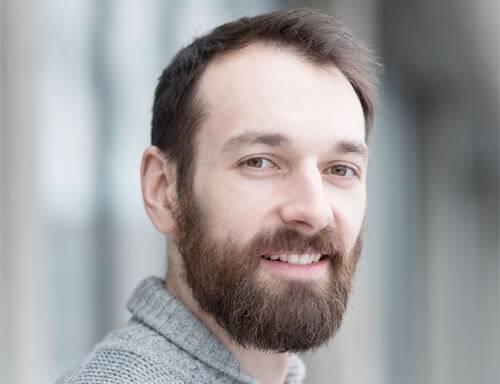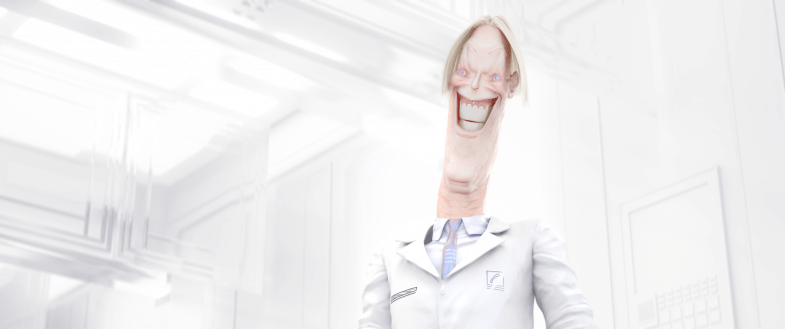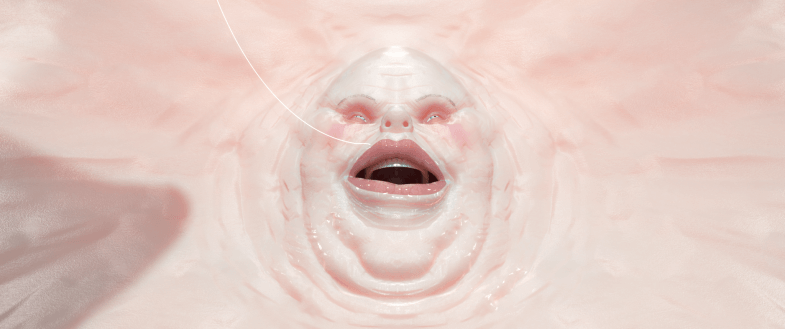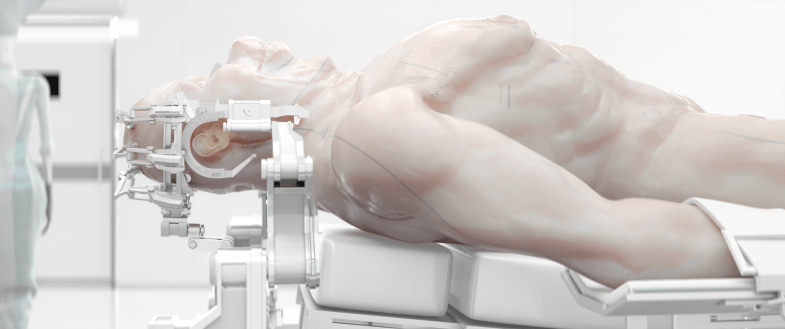Interview with ‘Caterpillarplasty’ director David Barlow-Krelina
One of this year’s truly astonishing new animated shorts will be unleashed on festival audiences on both sides of the pond this week. David Barlow-Krelina‘s Caterpillarplasty, is gorgeous, hideous, soothing and nightmarish all at once, depicting a sterile vision of the future in which humanity’s penchant for cosmetic ‘improvement’ has taken a morbid turn. Taking full advantage of recent leaps forward in CG rendering technologies, the enhanced materiality of the characters and their manipulations of skin and flesh make for a stomach-churning but ultimately captivating dark satire on beauty standards and body modification.
Having begun his relationship with the National Film Board of Canada as part of their Hothouse apprenticeship scheme (in which he directed the micro-short The Visitor) this latest project, having already picked up a Special Jury Mention at the Oberhausen International Short Film Festival, will this week continue its festival run at the Ottawa International Animation Festival in Canada as well as Encounters Short Film & Animation Festival in the UK.
Can you tell us a bit about your background and what originally drew you to the world of animation and filmmaking?
I was into art and building crafty things as a kid, model Corvettes, Avro Arrows, drawing still frames from Looney Tunes cartoons, inventing comic book characters and blueprints for imaginary spaceships. My dad always had a lot of interesting photography equipment and tools lying around the house. He had a VHS camcorder that I used to film skits with my friends, which were basically just videos of me and my buddies wearing mismatched outfits and re-enacting scenes we saw in movies. When my family got our first computer, I quickly learned that Photoshop and video editing was the best way to bring my art to life. By the time I was in high school I started learning Flash animation and began making cartoons and posting stuff on Newgrounds. I was inspired by David Firth’s Salad Fingers and Don Hertzfeldt’s film Rejected, both of which came out around that time. I loved the fact that these cartoons were created by just one guy. I wanted to do the same kind of thing.
In recent years we’ve spoken with members and alumni of the NFB’s Hothouse initiative. How did you find the experience of being involved in this and subsequent NFB projects (such as Subconscious Password) and to what extent have they contributed to your own process/artistic direction?
The NFB has been pretty monumental in my filmmaking evolution. I studied animation in Montreal and in my first year, we visited the NFB’s Open House to see the films in development and meet the artists. I came out of that experience on a major creative high, amazed at all the different projects and possibilities. The studios have always felt like they were right next door, and obviously a place that I wanted to be part of myself. I applied for Hothouse right after graduating and was thrilled to have been selected. I learned a lot about the technical process of filmmaking and working with a pipeline that integrates with the larger studio. To this day, much of my storytelling and creative process has built upon what I learned while working there. Over the years, the NFB has definitely grounded me within the animation history in Canada. Despite a lot of my process being 100 percent digital and relatively new, I’ve worked alongside other animators specializing in stop-motion, hand-drawing and paint on glass, and I’m sure the diversity of backgrounds has fed into my process.
For those like myself who are learning of your work through this latest film it would be great to hear more about some of your earlier projects/short films (such as Bless You) and the circumstances under which they came together.
I made Bless You as a side project on my own, working in parallel to other contracts. This was after the Hothouse internship and working on Chris Landreth’s film. I had a bunch of visual ideas in my sketchbook of grotesque facial expressions and unfolding bodies, combined with a wish list of technical processes I wanted to experiment with: digital fish-eye lens distortion, matte painting, stereoscopic 3D. I figured the best way to do it would be to put these things together into a new film. I love going to animation festivals, and my previous film, The Visitor, didn’t do so well, so I guess there was a fire in me to take another stab at it. I chose a simple idea for something I could do in a three-minute film and just ran with it. At the time, I had been rediscovering the music videos from the late ’90s/early 2000s and I wanted to make a film that had the same kind of energy and atmosphere. Bless You really kicked off at the Ottawa [animation] festival in 2013 and with the Staff Pick on Vimeo following that.
Where did the impulse to create Caterpillarplasty come from?
I like learning about biology, man’s complex relationship to nature and the drive to create tools and systems to conquer it. I wanted to do an ironic take on that. I like thinking about where we might be going with evolving technology. It’s exciting and scary to think of how things might change within our lifetimes and what we might leave behind. I wanted to create a glimpse into a hypothetical, somewhat absurdist, scenario. The great thing about the medium of animation is that it allows you to create these worlds and show people how it would be to live there, in an imaginative way. You get to build the entire universe from the ground up and think of how all the parts fit together. It’s quite exciting. Building the film is almost like watching slow-moving microbes grow in a petri dish, only here, you as creator are making the evolutionary decisions yourself.

David Barlow-Krelina (Photo: Yannick Grandmont)
You’ve cited Kafka and Kubrick as influences on the film, both of which are clearly identifiable. Were there any other major inspirations you drew from in putting the film together?
Science-fiction films from the ’70s and ’80s, including THX 1138, Alien, Blade Runner, Dune, and modern films that have a similar vibe, e.g., Beyond the Black Rainbow by Panos Cosmatos. There’s a trip sequence in Caterpillarplasty that draws on some of the hallucinatory visuals from Enter the Void and the Star Gate sequence from 2001. There was something really powerful about the footage of temples and large masses of people in the films Samsara and Baraka. These were definitely quite influential when designing the architecture of the Main Hall and Waiting Room. There’s an element of Chris Cunningham in there too, as well as modern 3D animation influences in the works of Jesse Kanda and Erik Ferguson. For the character design, I was pretty disturbed and fascinated by Ren & Stimpy cartoons as a kid. The drawing style of John Kricfalusi was something I went back to a lot with the designs.
The character design is particularly striking, what processes did you go through to fully develop their look?
I went back and forth between drawing by hand and digital sculpting. First starting with a rough line drawing on paper or in Photoshop. I like tracing over ink blotches and that sort of thing, turning random shapes into faces. I’ll do a number of these and then pick the ones that make me laugh, or find the shapes that work well in a series. Then I go a step further, refine the sketch, design in 3D, or do a bit of visual research with photo reference to make it more grounded. I’m fascinated by facial expressions so that’s usually where I start, and the rest of the anatomy evolves from there. I used ZBrush for a lot of the 3D sculpting and then I do material design in Redshift. First starting with a basic skin and then trying different variations on it—wet, rough, greasy, shiny, etc.—painting them onto the body almost like layers of digital varnish and testing them out under different lighting conditions in the renderer to make sure the highlights and reflections look nice and interesting.
In some respects the portmanteau title goes a long way toward explaining the film to the audience in its fusing of nature and unnatural cosmetic processes. From your own personal perspective what would you say the film is mostly about?
The film is about a culture with advanced technology whose citizens have the power to become anything they desire, but their ideals are so warped that they’ve lost touch with anything real, and so they strive to break out of the human species altogether. It’s a story about beauty ideologies blown out of proportion. The title of the film is the name of a cosmetic procedure within the film’s universe.
From this film, as well as Bless You, there’s clearly a strong handle on cinematography, pacing and effective interplay between music/sound and visuals. Were these developed during your education or has it always been intuitive?
I work with lots of temp tracks and time things out in a musical way, which lends itself to establishing visual rhythms and pacing in the work. The visual and auditory parts of my brain must be cross-wired in a weird way because I tend to see a lot of images when listening to music, and certain tracks have the power to trigger memories from various points in my life. I really like when the sound and visuals sync up in a one-to-one kind of way, sort of like those Windows Media Player visualizations. I guess for me it really makes the experience feel more complete, more holistic. But of course, that’s not to say there isn’t also something interesting about asynchrony. On Caterpillarplasty, I worked with some pretty talented people. The producer on the project, Jelena Popović, is an editor at heart, and the cinematographer, Luka Sanader, has a lot of experience working with cameras in live action, which really helped give the animation a classical film feel.
Can you elaborate on the role of the CG process ‘subsurface scattering’ and what that has brought to the film’s overall atmosphere?
Subsurface scattering is a 3D shading technique where the renderer simulates the effect of light hitting an object and scattering under the surface. In the case of the film, I used the technique to create the skin. It generally makes things look waxy, gummy or fleshy, and I think it played a pretty big role in making the surfaces feel more tactile. I’ve had friends say that looking at the characters made them want to reach out and squeeze them! I remembered first seeing this shading technique used maybe 10 years ago and thinking it was a major breakthrough that ushered in a new era of 3D animation, going from everything looking like plastic toys to, all of a sudden, real-life fleshy objects!
In tone and graphical style it stands out among the current crop of NFB output. How did you find the Film Board’s reaction to the premise/look of the film, and to what extent if any were they involved in its development?
The Film Board was pretty intimately involved all the way through the project, and some of the early conversations with my producer were quite formative in shaping the project. I submitted my initial proposal in a graphic style that was only an approximation of the final look, using hand-drawn images and some 3D experiments to show the idea. I had to learn a few of the production tools while on the job and so everything was constantly in evolution, and the final look only really came together close to the end. The core of the project was built around the idea of beauty, and I liked the idea of interpreting it in an ironic or subversive sort of way, and I think my producer liked that aspect of the film as well. One reaction that came up a few times with the Film Board was with regards to the meaning of the film’s ending, with questions about how the lead character felt about the result of his transformation. Was he happy? Did he get what he was looking for? What should we feel at the end of it all? I thought a lot about this and I wanted to come up with something feel-good with a degree of closure, but also something a bit off or contradictory.
As previously mentioned, the music in your films is very effective. What determines your choice of music style/composer when it comes to your work?
IDM and electronic music tends to be my default, so that’s usually my starting point for temp tracks and reference material. For this film, I started with some pretty heavy stuff from guys like Aphex Twin, Lorn and Arca, but then partway through the filmmaking process I started listening to these Vaporwave tracks. Hearing them alongside the film brought an element of irony/comedy to it that really worked for me. When finding a composer, I like sharing lots of reference tracks and seeing how they relate to the overall vibe. If there’s one instrument or sound that I’m really attracted to, I’ll be sure to pick it out and try to build the discussions around it, imagining how other sound elements will relate to it and what new things could be brought in. Ultimately, it’s an organic process that goes back and forth with the visuals feeding into the music and vice versa, and it helps a lot to feel a close sense of rapport on a personal level with the composer.
This might seem like an obvious question, but do you have any strong feelings on the pervasive role of beauty standards and cosmetic surgery in society?
It’s been interesting to see how different cultures have their own preferred beauty looks that shift from one geographic region to another. What strikes me about this is how relative the beauty standards are. It’s almost as if on a whim, the culture has arbitrarily selected some features to be more preferable than others. For example, in Korea, some women have their jawbones surgically shaved down because having an oval-shaped face is more preferable than a square one. I think that’s pretty intense, and it would make me sad to think that someone would do such a thing just to fit in. It’s complex because people are free to do what they want with their own bodies. The film speaks about the universal striving for something bigger, humankind’s perpetual striving to attain divine ideals that are impossible to grasp, and the great lengths and crazy things we do to get there.
The film plays this week as part of the Encounters Festival’s notorious Late Lounge programme – was the film conceived as something that would challenge/disturb audiences or did that just come with the territory?
In making the film, I was trying to put a finger on a strange kind of feeling having to do with human tissues and machines coming together in unpredictable ways. Maybe this is a bit disturbing, but also very interesting! But yeah, I like the idea of making something that could cause people to cringe!
Your bio mentions that both of your parents worked in the medical field – was this something that had a bearing on the development of Caterpillarplasty?
I’m sure it had some sort of bearing on the film. Both of my parents are psychiatrists, so they do talk therapy and that sort of thing. Neither of them does any kind of surgical work, however growing up in a family of doctors has meant being surrounded by a lot of medical jargon. Knowing all the names of the different diseases and their symptoms has maybe given me a bit of anxiety about whether I have them myself! My dad used to work in a hospital setting and as a kid I used to go visit the building with him sometimes in the off-hours as he was picking up paperwork, and I remembered seeing all this scary-looking equipment in the shadows: metal devices and consoles with flashing buttons. He also used to have these plastic anatomical reference sculptures of the inner ear and brain, and X-ray negatives on photographic plates. I thought it was so interesting to look inside the body.
What’s next for you?
At the moment, I’m taking it day by day. The film was honestly a pretty long journey for me. I’m really looking forward to diving into a big new film, but right now I’m simply gathering up momentum at my own pace. I really want to build on the grotesque beauty of Caterpillarplasty and design anther film universe in a similar style, making things more visceral, more grotesque, more psychedelic. I’d really love to work with actors and performance capture. Working long hours behind a screen can be a bit isolating. I’d like to interact with real people through my work!
Caterpillarplasty screens this week at the Ottawa International Animation Festival (Short Film Competition 1, 9:15pm 26/09 and 11am 29/09) and Bristol’s Encounters Festival (Late Lounge: Body Parts, 10pm 27/09) with further screenings at the Vancouver International Film Festival (8:45pm 30/09 and 3pm 07/10) and Sitges (12:30pm 07/10) to follow.
For more on the work of David Barlow-Krelina visit davidbk.com




